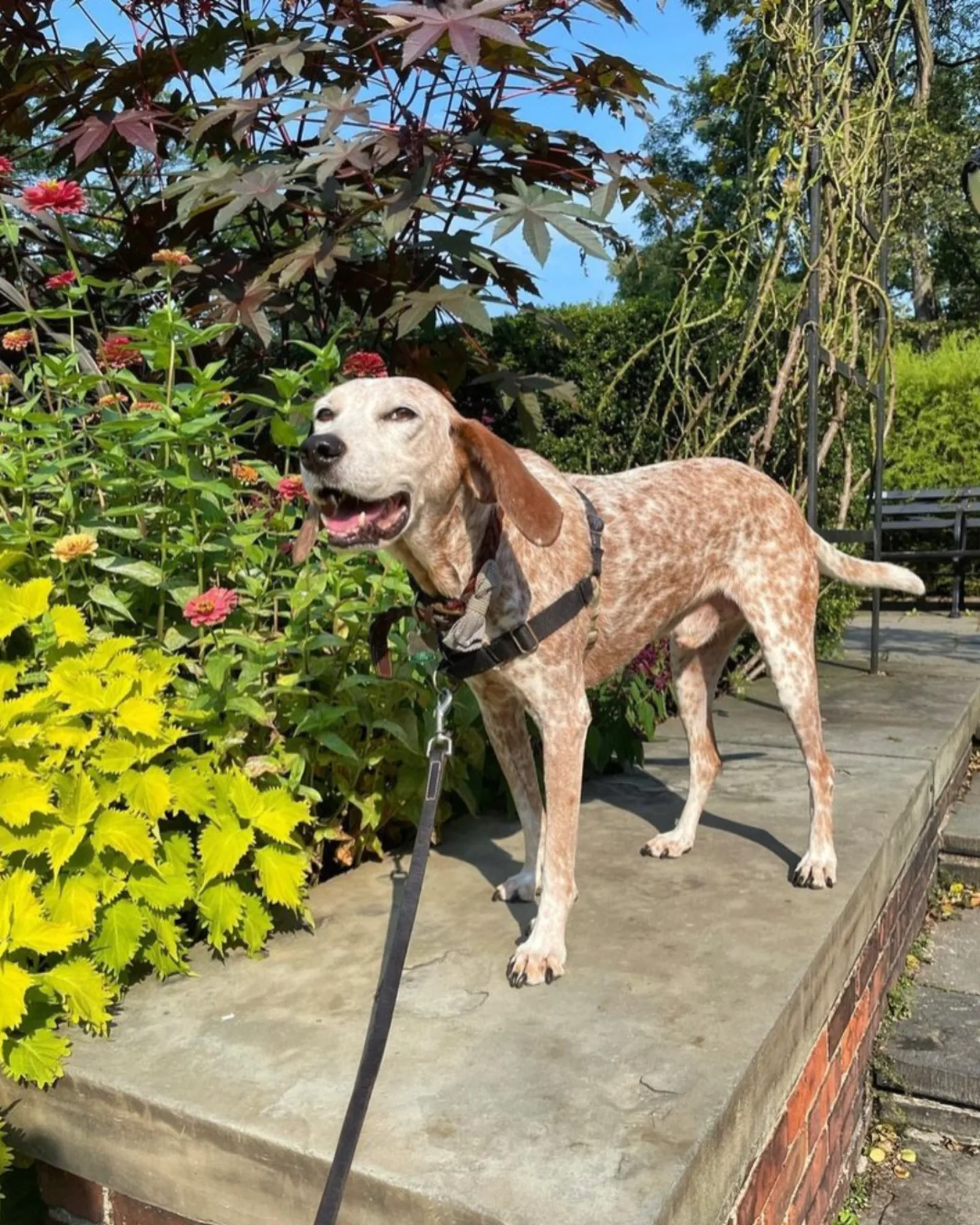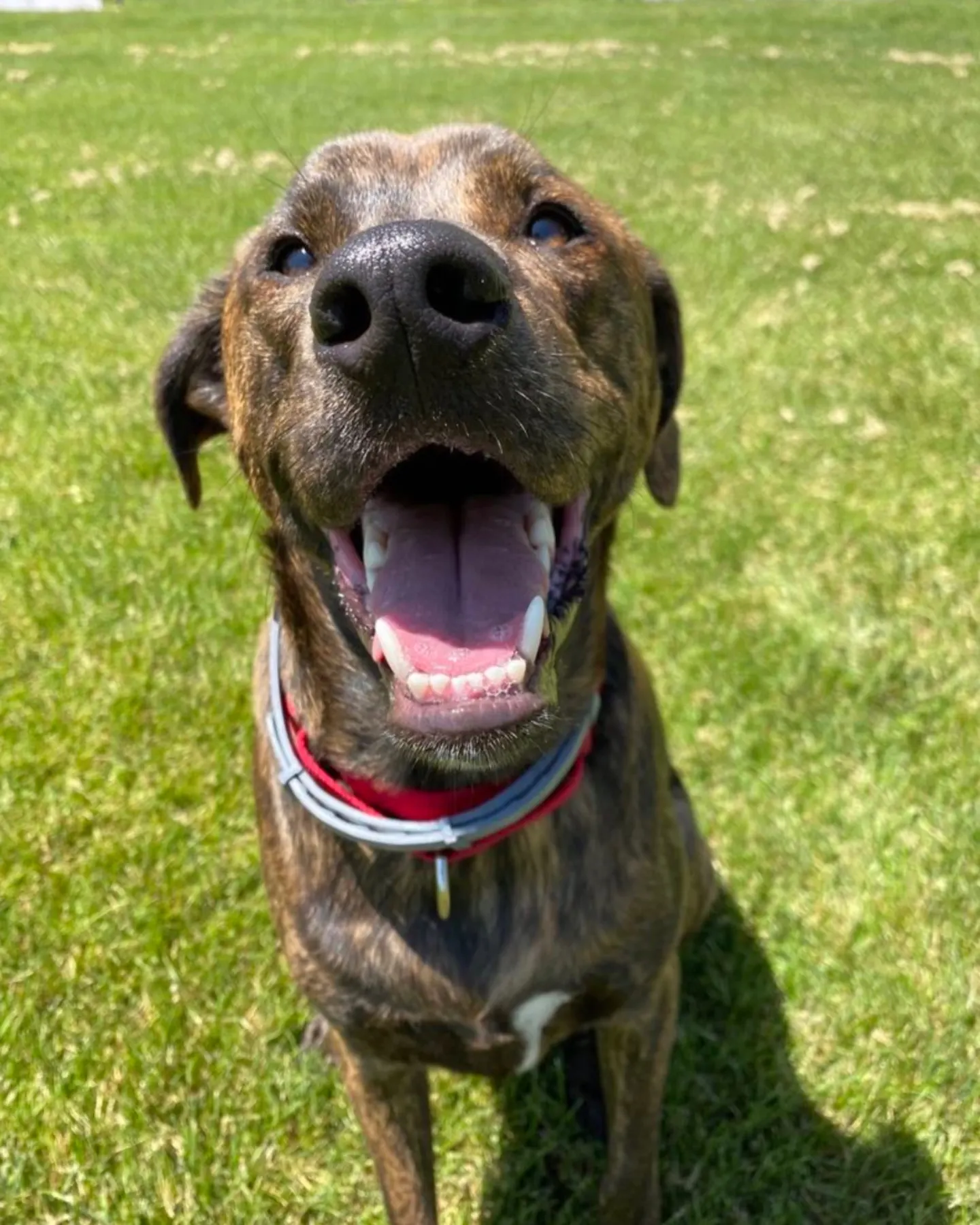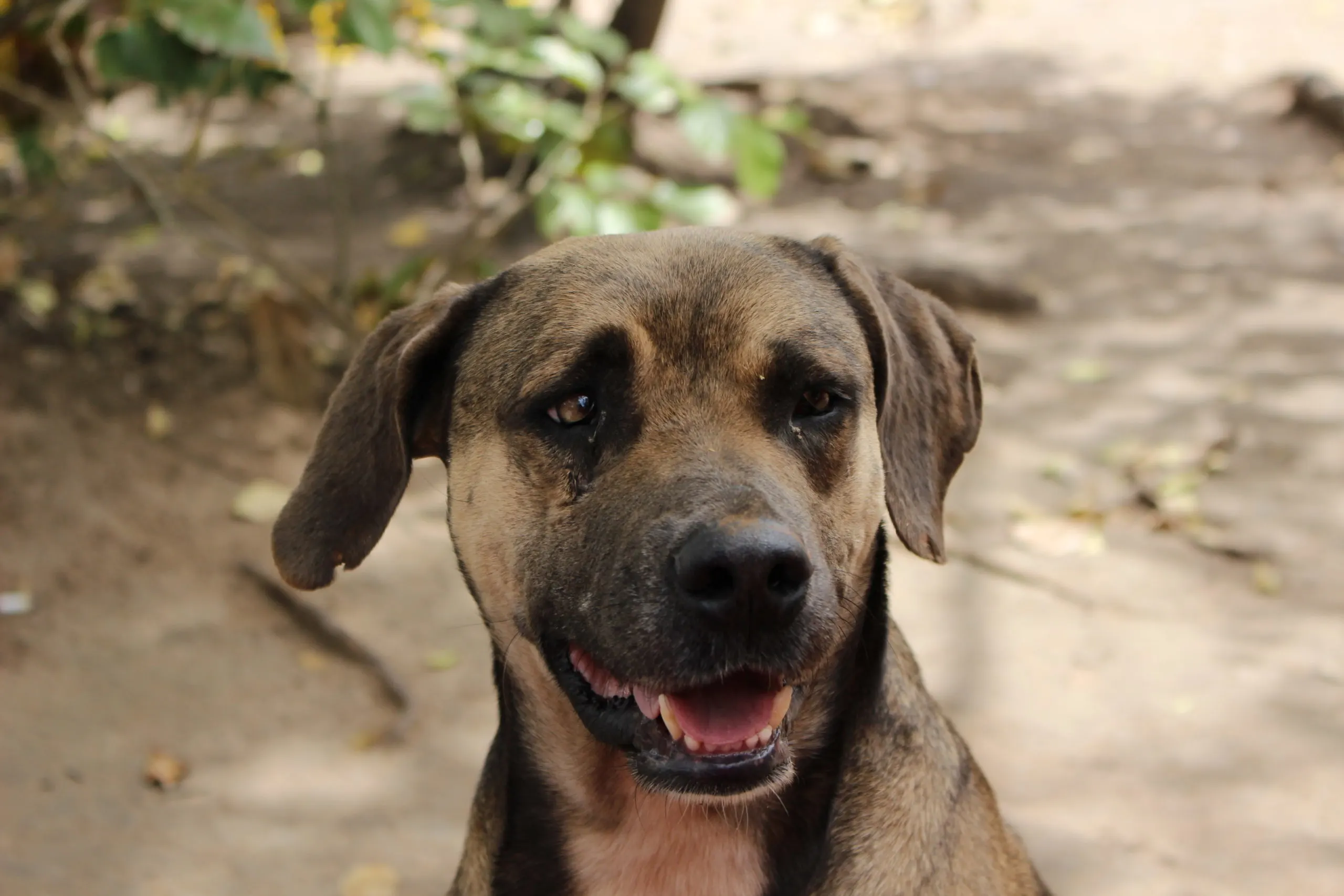The Plott hound is a medium-to-large hound dog breed from the United States. It has a short, shiny coat that is usually brindle. The dog’s ears are about the same size as its head and hang down. Its eyes are usually brown or hazel. Its skin is smooth and flat, unlike that of the bloodhound and many other hound dog breeds. Overall, it is big and strong, with long legs that help it move quickly and keep going for a long time. The Plott hound is usually loyal and eager to please, and it can be a dedicated and fearless hunting dog.
Plotts do best in the country, where they have lots of space to run around. They need a lot of exercise and, because they used to hunt in groups, would probably do best in a home with at least one other dog. This breed needs to be socialized a lot. If you bring one of these puppies home, make sure you have a high fence and a big yard. They love running and going places and are true escape artists. That’s why a fence is mandatory.
The Plott Hound is known for having a robust and slim body, being smart, loyal, and eager to please. Because he was made to hunt bears and wild boars, he is not only strong but also fierce when he is on the hunt. Male Plotts are 20 to 27 inches tall at the shoulders and weigh 50 to 75 pounds. Females are 20 to 25 inches tall and weigh 40 to 65 pounds.
If you want to learn more about the Plott dog breed and see if this is the right dog to add to your family, keep on reading.
History of the Plott Hound
The Plott hound comes from Germany, which is different from many other hound breeds that come from the United Kingdom. In the middle of the 1700s, a German man named Johannes Plott brought five Hanover hounds with him to North Carolina.
The Plotts used these dogs to hunt big animals like bears and wild boars. And eventually, they crossed their Hanoverian Schweisshunds with local hunting dogs to make the Plott hound. The breed is known for both its ability to track scents and its loud, musical bay, which can be heard from a long way away. The dogs were passed down through Plott’s family, and they became known as Plott’s hounds.
They moved around the Smoky Mountains, where each hunter gave them his own traits. Eventually, they went back to their roots and were used to hunt wild boar as well as bears. They were also used to hunt mountain lions and raccoons after the right crosses were made to make them better at climbing trees.
At the beginning of the 20th century, a cross with some black-and-tan hounds owned by a man named Blevins gave the Plotts a better sense of smell and the black-saddled brindle pattern. Today, most Plott Hounds can trace their ancestry back to Tige and Boss, two famous dogs who were born from this cross.
In 1946, the United Kennel Club began to record the breed. Since 1989, this breed has been North Carolina’s state dog. In 2006, the American Kennel Club recognized the Plott dog breed. This breed is still pretty rare, though, and most people see him in the Appalachian Mountains, the Smoky Mountains, and other wild places where his hunting skills are valued.

Source: Instagram (@coonhoundfans)
Personality
The Plott Hound usually has a calm personality, and he’s happy to be part of the family if he has a fenced-in acre to roam or a fenced-in yard with lots of exercise, a strong leader, and, ideally, the chance to hunt. Because he likes to be in charge, the Plott Hound is not a good choice for a first-time dog owner. He has a mind of his own and it isn’t easy to train him.
Plotts aren’t afraid of anything and are more protective than most dogs. They are loyal to their people and will protect their property, but they are also friendly enough to be nice to everyone they meet. These dogs do well in homes with kids, but they do best with older kids who know how to act around dogs. They are pack animals, and they like the comforts and company of living with other dogs.
The Plott is said to be smart, kind, sure of himself, and brave. He loves his family and is wary of strangers, but he usually gets along with them quickly. He gets along fine with other dogs, but he prefers to be with dogs of the same breed or at least the same size.
People often notice that Plotts bred to hunt big game and those bred to catch raccoons in trees have different personalities, with the big game dogs having a sharper edge. The Plott is a hound, so he has his own mind and needs firm, consistent guidance, but he wants to please his people in general. He looks out for his home and family and is a great watchdog.
Are they good family dogs?
Most of the time, Plott hounds are loyal and protective of their family, but they can be wary of strangers. With the proper training, they can get along with other dogs, but smaller pets in the house might look like food to them. This breed’s personality is also shaped by its high energy, and it likes to be busy.
Plott Hounds do well in homes with children, but they do best with older children who know how to behave around dogs. Plotts can be very possessive of their food bowls, which can make it hard for a small child to grab a handful of kibble.
Always show kids how to approach and touch dogs, and always watch when young kids and dogs are together to make sure no one bites or pulls on the other’s ears or tails. No matter how nice you think your pup is, you shouldn’t ever leave children and dogs unsupervised.
Caring for a Plott hound
Even though Plott Hounds love to relax on the couch with you, they need their exercise. The Plott is not a jogger; he is a walking partner. He likes just to wander around and find new paths. They are for people who enjoy nature and easy living. They will be at their happiest when they are with you on a slow-paced walk somewhere outside of the city.
Plott Hounds should always be on a leash when they’re not in an enclosed area, and when they’re left outside, they should have a fenced yard. They will get lost because they have no sense of direction. They will follow an interesting path for miles, and they could easily get lost. No matter how much they enjoy being outside, this is still an indoor dog breed.
Because they are smart and eager to please, Plott Hounds are not too hard to train. They do have a tendency to be bossy, so they aren’t good for people who aren’t sure how to be consistent with rules and commands. Plotts respond well to positive reinforcement. They will appreciate both verbal praise and snacks or treats.
Plott Hounds need to be socialized so they don’t get aggressive. Socialization classes are a great start, and many obedience schools offer them. While they do good with other dogs, cats and other small animals could be seen as prey by the Plott.
Grooming the Plott hound
The short coat of the Plott hound stays clean and only needs basic grooming. Use a soft-bristled brush or grooming mitt once a week to get rid of loose fur and spread skin oils. Shedding can get worse at certain times of the year, usually in the spring and fall. When this happens, you’ll need to brush your pet more often to keep up with all the loose fur.
Bathe your dog about once a month, or more often if it gets very dirty. Make sure you use a gentle dog shampoo that won’t strip his coat of its natural oils and won’t dry out his skin either.
Make sure to check its ears at least once a week to see if they need to be cleaned. If needed, clean them with a couple of cotton balls and a cleaning solution. This is especially important for pendant dog ears, like the ones the Plott has. They easily get clogged with wax and dirt. In addition to that, also dry their ears whenever they get wet. Don’t forget about your dog’s nails either, and make sure you or your dog groomer trim them whenever they get too long.
And last but not least, it’s important to take care of your dog’s teeth too. Ideally, you should brush them every day, with a dog toothbrush and toothpaste. However, brushing their teeth three times a week will also work well and prevent serious dog dental problems from forming.
Exercising
Every day, you should plan to give your dog at least one to two hours of exercise. A Plott hound that is bored and doesn’t have a way to use its energy might do something destructive. Long walks, hikes, and playing in the yard are all great ways for this breed to burn off some of its energy. Also, dog sports like tracking and agility can challenge both the dog’s mind and body. And toys like puzzles can help keep the mind active as well.
When your Plott hound is outside, keep it on a leash or in a safe area with a fence. Because the breed has a high prey drive, it might run off after what it thinks is prey. Also, he might not always listen to your recall commands. That’s why it’s also important to have a high fence if you exercise your dog in your yard without a leash on.
Training the Plott hound
When it comes to training, Plott hounds can be a bit stubborn. Start training and socializing your dog when he or she is a puppy, if possible. Always use positive reinforcement training methods, like treats and praise. And try to make training fun and different so that your dog stays interested.
Also, try to get your dog used to different people, other dogs, and places as soon as possible. Socializing this dog is very important because of their history as a hunting dog breed and their strong prey instincts.
Crate training your Plott Hound will help him learn where the bathroom is and keep him from destroying your things. But you shouldn’t keep your Plott in a crate all day. It’s not a jail, so he shouldn’t stay there for more than a few hours at a time unless he’s sleeping. Plotts are dogs for people, so they shouldn’t spend their whole lives in a crate or kennel.
This breed needs to be trained to walk on a leash. He likes to wander and doesn’t know how to behave around cars. With the right training, socialization, and rules, the Plott Hound is not only a great hunting partner by day, but also a great foot warmer at night.
Nutrition
Just like people, dogs are all different, so they don’t all need the same amount of food. The quality of the dog food you buy is also important. It’s not all about the price either. Make sure that the food you purchase for your pup is full of nutrients and protein. Avoid filler foods such as corn or cereals.
The Plott is prone to gastric dilatation-volvulus, or “bloat,” is the Plott. This can be a deadly condition, but luckily, it’s pretty easy to prevent. Feed them twice or three times a day instead of just once, and don’t let them work out right after they eat.
Make sure your Plott Hound can always get fresh water, especially during the summer months. A healthy, well-balanced diet with enough exercise will make sure your dog stays fit and in good health. The recommended daily amount of food for this breed is between 2 and 3 cups. This should be split between at least two meals. Talk to your vet about the amount and type of food to make sure you’re meeting your dog’s specific needs. Diets can be different based on age, level of activity, and other things.

Source: Instagram (@dino_the_good_boy)
Health of the Plott dog breed
Plotts are usually healthy, but like all breeds, they can get sick from time to time. The most important thing you can do to make sure your dog is healthy as possible is to buy puppies from reputable breeders. Reputable breeders should do all of the important health screenings and genetic tests. This will check if your dog inherited some diseases from its parents.
They have an average lifespan of 13-15 years, and most of them will stay healthy for most of their lives. However, some health concerns that you have to be aware of include hip dysplasia, bloat, elbow dysplasia, diabetes, pneumonia, and cancer.
Conclusion: Is the Plott hound the right dog for me?
The intelligent Plott dog breed is part of the hound group, which makes them a great choice for hobby hunters who also enjoy relaxed family life. He will be a loyal companion as long as he gets regular training sessions from an early age, a couple of long walks a day, and lots of attention the rest of his time.
There are purebred dogs with a unique history who are also known for their beautiful, flashy coats that don’t need much grooming. You have different options when it comes to color and appearance traits as well. While most of them are black with brindle trim, they also come in solid black, red fawn, tan, and cream. They have a long tail and legs, which makes them one of the faster hound breeds.
The Plott hound barks in a specific, high-pitched manner, which could be a bit surprising at first. Make sure you give them early training since puppyhood, so they don’t bark for no reason.
The Plott hound is not a very common breed of dog, but you can still find one that is up for adoption. On average, you can expect to pay between $300 and $700 for a puppy from a good breeder, or around $200 in adoption fees. Make sure you always do a little research on the parents before getting a puppy.

